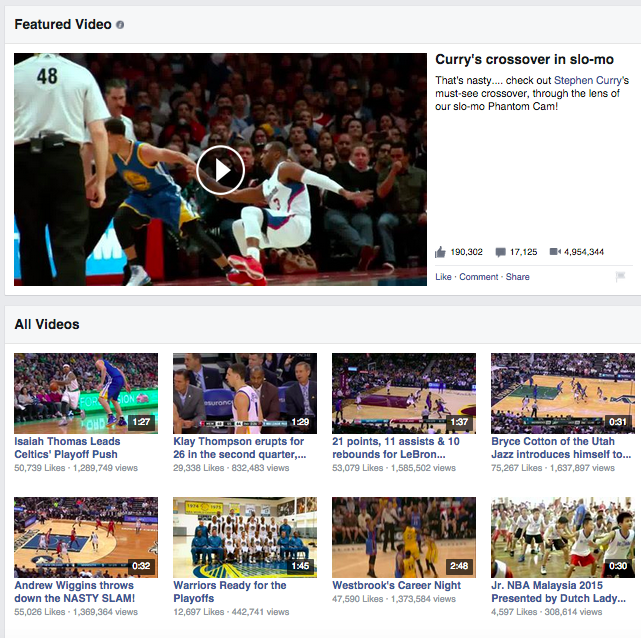There are a lot of different avenues to take when it comes to video content now. It’s easier than ever to get video content to the masses with Twitter video, YouTube, Periscope and more.
As video mediums and tools continue to rise, it becomes increasingly more important to reach fans where they are. It’s not about a this or that approach to video tools and platforms. Instead, it’s about leveraging them all to reach the greatest number of fans wherever they prefer to consume.
If you want to ensure you use each platform/tool effectively, then think about creating an internal guide on video platform best practices. Below is a guide to start thinking about the differences:
YouTube
Before Twitter, Video and Instagram rolled out their own video capabilities, YouTube was always relied on. And while it’s not the only answer to video anymore, do not neglect the platform.
YouTube is not just a distribution channel. It’s a community. A community that reaches more US adults 18-34 than any cable network and has 1 billion visitors every month. Unlike Facebook, Twitter or Instagram, users are going to YouTube to seek out video content. There’s a certain value to that.
Teams should focus on a specific platform strategy for YouTube, just like they do every other platform. Take note of the content that works best, use YouTube playlists, leverage the annotation features and engage with users. Don’t forget to cross promote the content on Twitter too!
When it comes to content on the platform, anything is fair game. With no limits on length, YouTube is a great hub for more “long-form” features (even those 2 – 3 minutes). At the end of the day though, to be successful on YouTube is all comes down to create compelling content like every other platform.
Long-form storytelling, hype videos and behind-the-scenes features work well on YouTube. Here are some examples of how teams are using YouTube:
Facebook Video
Facebook has allowed brands to upload video directly to the platform for quite some time now. And between their focus on video content and autoplay, native video on Facebook outperforms any other video content on the platform.
No matter what type of video content you are looking to share on Facebook, it makes sense to go ahead and upload it directly there. There’s no reason teams should share any video links. Take a look at the NBA’s numbers on Facebook and you’ll get a sense of the reach:
Just like YouTube, all kinds of video lengths and features work well with native Facebook video. Again, it all comes down to sharing content that resonates.
Twitter Video
Twitter video is a great tool to tell a more seamless and instant story by posting video (30-seconds or less) directly to the platform. Twitter video is not a platform with its own community like Vine or Instagram, but another tool to help you create content for Twitter.
With the 30-second limits, Twitter video is a great to share player/coach interviews, quick behind-the-scenes content, the game atmosphere, etc. The content does not have to be polished; the real value is in sharing a quick and raw perspective.
Here’s a look at a few ways teams are using Twitter video:
Coach K is a pro at cutting down nets.
He's had lots of practice.https://t.co/KKlv1ZMsWv
— NCAA March Madness (@MarchMadnessMBB) April 7, 2015
One of 10,000 reasons we're gonna miss @FSKPart3 pic.twitter.com/4cUSwRcSkw
— Wisconsin Basketball (@BadgerMBB) April 10, 2015
Warming up the bats at BP today http://t.co/zJS9PcU45I
— San Diego Padres (@Padres) April 15, 2015
Vine
Unlike Twitter video, Vine is its own social media network where video content is shared directly on Twitter’s timeline. The short, looping video platform has built a strong, niche community. One that loves humor, elements of surprise and excitement. If you want to know what content works best on Vine, answer this simple question: Is this something I would want to watch over and over again?
Because of the looping factor and short content bursts that Vine lends itself too, content that evokes emotion works best here. Think about awe, surprise, humor and shock. In addition, teams also capitalize on Vine’s tap feature that stops and starts the action to engage fans in a deeper way.
Here’s a look at a few ways teams are using Vine:
Periscope/ Meerkat
Live streaming is the latest craze that has taken the social media/tech world by storm thanks to Periscope and Meerkat. Both apps allow you to stream live video from your phone to all your followers.
While there’s still a long way to go in figuring out the value in live, it’s hard to deny that there’s something special about it. Kelly Mosier of the Huskers nailed it when he said “the draw for Periscope/Meerkat is giving people a seat to something first hand, in real time. Live is uncomfortable, but powerful.”
So far we’ve seen teams use it to live stream practice, interviews, behind-the-scene looks, press conferences, etc.
When thinking about how to use Periscope/Meerkat, ask what the value of live brings. Is this moment so intimate, important or emotionally fueled that watching it “now” is important. Does it make sense to forgo quality to provide the coverage instantaneous? If there’s value in brining your fan into the moment right then and there for a front-row seat, then Periscope and Meerkat could be the way to go.
In the future, video content is only going to continue to grow. It’s time to invest time and energy to figure out how you can tell your story through video and maximize all the tools for optimal reach!
What video platforms/tools do you think will continue to grow in the future? Share your thoughts below!
Thanks for reading!
